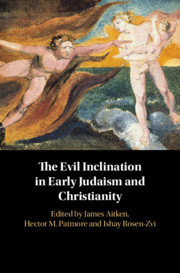Book contents
- The Evil Inclination in Early Judaism and Christianity
- The Evil Inclination in Early Judaism and Christianity
- Copyright page
- Contents
- Acknowledgments
- Contributors
- 1 Introduction
- 2 Reconsidering the Semantics of the “Inclination” (yeṣer) in Classical Biblical Hebrew
- 3 The “Inclination” (yeṣer) as Rendered in the Septuagint
- 4 “Fleshly Spirit” and “Vessel of Flesh” in 4QInstruction and the Thanksgiving Hymns
- 5 Theological Anthropology in the Enochic Tradition
- 6 The Perils of Philosophical Persuasion: Philo on the Origin of Moral Evils
- 7 The Evil Inclination (yeṣer ha-ra‘) in Tannaitic Literature: Demonic Desires and Beyond
- 8 Conflicting Intrapersonal Powers in Paul’s Letters
- 9 The “Two Inclinations” and the Double-Minded Human Condition in the Letter of James
- 10 An Evil Inclination in the Early Targums to the Pentateuch and Prophets?
- 11 “Gnostic” Theologies of Evil
- 12 The Rabbinic “Inclination” (yeṣer) and the Christian Apocrypha
- 13 Origen on the Origin of Sin
- 14 Augustine on the Diabolical Suggestion of Sin
- 15 Jerome and the “Inclination” (yeṣer): The Evidence of the Vulgate
- 16 Rabbinic Inclinations and Monastic Thoughts: Evagrius Ponticus’ Doctrine of Reasoning (logismoi) and Its Antecedents
- 17 “Inclination” (yaṣrā) in the Syriac Tradition
- 18 Evil, Sin, and Inclination (yeṣer) in Jewish and Christian Poetic Disputes between the Body and Soul
- 19 The Wizard of Āz and the Evil Inclination: The Babylonian Rabbinic Inclination (yeṣer) in Its Zoroastrian and Manichean Context
- 20 The Evil Inclination in the Targums to the Writings
- References
- Index of Names
- Index Locorum
13 - Origen on the Origin of Sin
Published online by Cambridge University Press: 02 February 2021
- The Evil Inclination in Early Judaism and Christianity
- The Evil Inclination in Early Judaism and Christianity
- Copyright page
- Contents
- Acknowledgments
- Contributors
- 1 Introduction
- 2 Reconsidering the Semantics of the “Inclination” (yeṣer) in Classical Biblical Hebrew
- 3 The “Inclination” (yeṣer) as Rendered in the Septuagint
- 4 “Fleshly Spirit” and “Vessel of Flesh” in 4QInstruction and the Thanksgiving Hymns
- 5 Theological Anthropology in the Enochic Tradition
- 6 The Perils of Philosophical Persuasion: Philo on the Origin of Moral Evils
- 7 The Evil Inclination (yeṣer ha-ra‘) in Tannaitic Literature: Demonic Desires and Beyond
- 8 Conflicting Intrapersonal Powers in Paul’s Letters
- 9 The “Two Inclinations” and the Double-Minded Human Condition in the Letter of James
- 10 An Evil Inclination in the Early Targums to the Pentateuch and Prophets?
- 11 “Gnostic” Theologies of Evil
- 12 The Rabbinic “Inclination” (yeṣer) and the Christian Apocrypha
- 13 Origen on the Origin of Sin
- 14 Augustine on the Diabolical Suggestion of Sin
- 15 Jerome and the “Inclination” (yeṣer): The Evidence of the Vulgate
- 16 Rabbinic Inclinations and Monastic Thoughts: Evagrius Ponticus’ Doctrine of Reasoning (logismoi) and Its Antecedents
- 17 “Inclination” (yaṣrā) in the Syriac Tradition
- 18 Evil, Sin, and Inclination (yeṣer) in Jewish and Christian Poetic Disputes between the Body and Soul
- 19 The Wizard of Āz and the Evil Inclination: The Babylonian Rabbinic Inclination (yeṣer) in Its Zoroastrian and Manichean Context
- 20 The Evil Inclination in the Targums to the Writings
- References
- Index of Names
- Index Locorum
Summary
In a volume on the origin of sin a contribution about Origen should not be missing, but this is not because his name has anything to do with the term “origin.” Although in other languages his name is sometimes erroneously spelled Origines, which suggests a relationship with the Latin word origo (gen. originis), Origen’s name (Ὠριγένης, Ōrigenes in Greek) derives from the Egyptian god Horus and means “son of Horus.” A variant of his name is aspirated by the editors as Hōrigenes, showing more clearly the derivation from the name Horus.
- Type
- Chapter
- Information
- The Evil Inclination in Early Judaism and Christianity , pp. 201 - 211Publisher: Cambridge University PressPrint publication year: 2021

